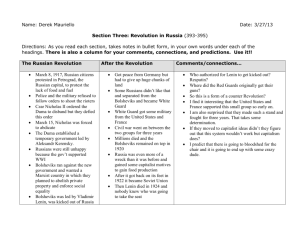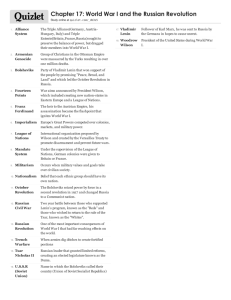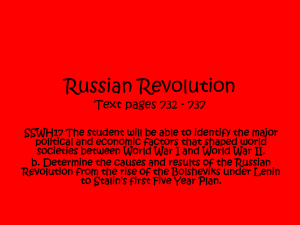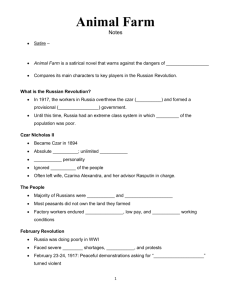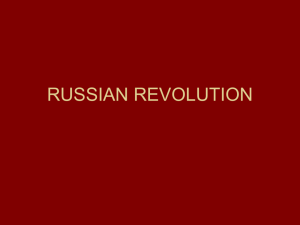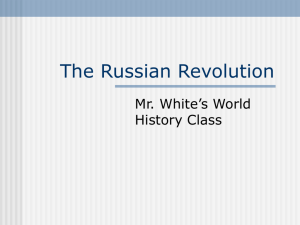The Russian Revolution
advertisement
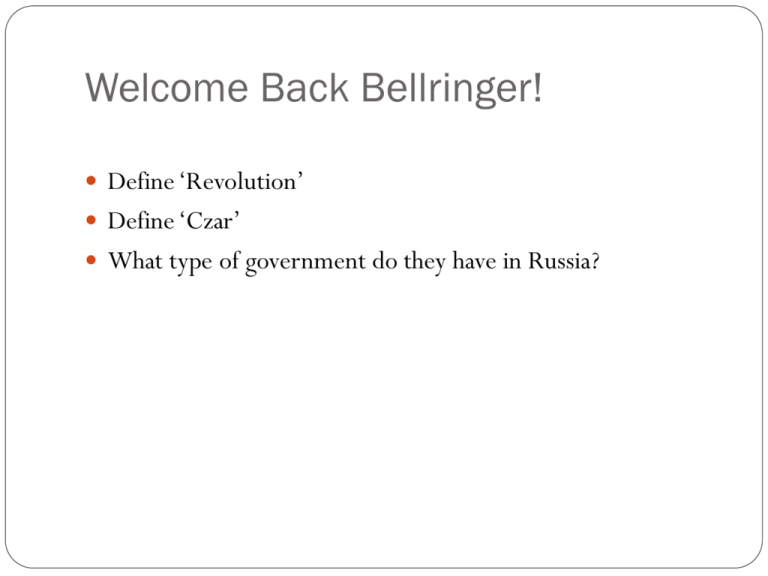
Welcome Back Bellringer! Define ‘Revolution’ Define ‘Czar’ What type of government do they have in Russia? Good morning! Pick up a chart from the front table Sit down and copy the questions in one box Answer the question in the next box THESE COME STRAIGHT FROM THE FINAL EXAM…YOUR EXAM IS IN 2 and a half WEEKS!!!! What civilization developed between two rivers? The combination of religious and political authority in Egypt is known as? The Great Wall of China was built to keep out what group of people? What civilization developed between two rivers? The combination of religious and political authority in Egypt is known as? The Great Wall of China was built to keep out what group of people? The Russian Revolution The Romanov Family Ruled Russia for 300 years Czar Nicholas I Wife of Nicholas I was German born Son Alexander II Grandson Alexander III Great Grandson Nicholas II http://www.history.com/topics/russianrevolution/videos/historys-burningquestions-the-romanovs Autocracy in Russia Form of govt. where one leader has total power In 1881 Alexander III is Czar in Russia At this time anyone who questioned the absolute authority of the czar, worshiped outside the Russian Orthodox Church, or spoke a language other than Russian was labeled dangerous To wipe out revolutionaries he used harsh measures Teachers must send detailed reports on students Political prisoners sent to Siberia Oppressed other national groups in Russia Refused the use of any language other than Russian Made Jews the target of persecution Industrialization in Russia Russia is the world’s 4th leading producer of steel Rapid industrialization caused discontent among the people of Russia. What are the problems with industrialization? Several revolutionary movements are established. Group that follows the views of Karl Marx- believed that the industrial class of workers would eventually overthrow the czar. Russian Marxists split into two groups- The Mensheviks and the Bolsheviks (they become the Communist Party of the Soviet Union) Leading to Revolution Russo-Japanese War (1904-05) This war was meant to increase the prestige and power of the autocracy at home and abroad, but resulted in a humiliating defeat for Russia. This war marked the first time any Asian power had defeated a European power in a real war. With the defeat, Japan emerged as a threat to Russian interests in the east and, in Russia, people lost confidence in their govt. Bloody Sunday The Tsar’s troops open fire on a peaceful demonstration of workers in St Petersburg. January 9, 1905; peaceful marchers in St. Petersburg carried a petition to Tsar Nicholas II asking for higher wages, a shorter work day, better working conditions, a legislative assembly, and universal manhood suffrage, hoping reform would come from above. In reaction, Nicholas II ordered his guard to fire into the unarmed crowd; when news of 100 dead and 100s more wounded got out, people turned against the Russian govt. The straw that broke the camels back…WWI Russia was dragged into WWI in 1914 They were unprepared to handle the military and economic costs They possessed weak generals and poorly equipped troops which were no match for German armies Defeat followed Defeat Before a year had passed over 4 million soldiers had been killed, wounded or taken prisoner Czar steps down In Feb. of 1917 czar Nickolas was forced to abdicate his throne, the Romanov Dynasty ends in 1917. The revolution had succeeded in taking down the czar yet had failed to set up a strong govt. to replace his regime. Provisional Government- temporary government Alexander Kerensky headed it. He decides to stay in the war. Angry peasants demanded land City workers grew more radical Socialist revolutionaries, competing for power, formed soviets Soviets- local councils of workers, peasants, and soldiers. In many cities the soviets had more influence than the provisional government. In textbook Read pgs 867-873 #1,3-6 Also answer “What was Lenin’s main concern with Stalin?” Pg 874-879 #1,3-5,7,8 Vladimir Lenin “Father of Revolution” Major leader of the Bolsheviks Had an engaging personality and was an excellent organizer He was ruthless Wanted to create a socialist economic system in Russia Bolsheviks – November Revolution Bolshevik means “majority” “Peace, land, and bread”- Lenin’s campaign slogan Armed factory workers stormed the Winter Palace in Petrograd. They called themselves the Bolshevik Red Guards –took over govt. offices and arrested leaders of the provisional govt. Overthrew provisional government New symbol of government – Red flag with entwined hammer and sickle symbolized union between peasants and workers Bolsheviks renamed communists Civil War (White vs. Red) Lenin signed Treaty of Brest-Litovsk with German.—Lenin gave piece of western Russia to Germany. Starts a civil war for 3 years Whites—counterrevolutionaries loyal to Czar, who favored socialism or democracy. Reds are communist supporters US sends military aid and aids the White army side…however they were of little help Effects of the Civil War 14 million Russians died Red army dominates Bolsheviks seized power The Russian revolution had attempted to destroy existing social and political structures They had used violence and terror to control people Similar to the French Revolution Take out your Final Exam Warm ups Absolute ruler of France who built the Palace of Versailles Enlightenment philosopher who proposed “life, liberty, property” German monk who questioned the practices of the Church, led to the Protestant Revolution Review from yesterday What were “soviets”? Local govts. who opposed the provisional government. Wanted communism. What political party did Lenin lead? Bolsheviks (means “majority) What did Lenin promise his people? PEACE, LAND, AND BREAD What was the new symbol for government? Hammer and sickle (unity between workers and farmers) Who fought in the Russian Civil War? WHITES (democratic) and REDS (communist) What was Lenin’s NEP? Let farmers sell crops and items for their own profit USSR Bolshevik leaders saw nationalism as a threat to unity and party loyalty Lenin organized Russia into self-governing republics under the central government. In 1922 the country was named the Union of Soviet Socialists Republics, in honor of the councils that helped launch the Bolshevik Revolution He instituted the New Economic Policy (NEP) in the early 20’s which semi-capitalistic, such as allowing farmers to sell portions of their grain for their own profit. The plan was successful in agriculture. In late 1922 Lenin suffered a stroke, this sparks thought of who will lead after him TAKE OUT A PIECE OF PAPER Stalin Was cold, hard and impersonal Stalin means ‘ man of steel’ Lenin believed Stalin was a dangerous man Before he died in 1924 Lenin wrote “Comrade Stalin… has a concentrated enormous power in his hands and I am not sure that he always knows how to use that power with sufficient caution.” By 1928 Stalin was in total command of the Communist Party (really totalitarianism) People didn’t share the profits and had no choices regarding participation Stalin’s Five Year Plan Believed that the NEP was incredibly slow, so he called for faster agricultural production by ruthlessly taking over private farms and combining them into state-owned enterprises The plans also called for the construction of large nationalized factories Process was achieved in the name of communism but it was actually totalitarianism “The Great Purge” Stalin’s plans successfully industrialized the USSR and improved economic conditions for the country as a whole Stalin relied on terror tactics Secret police force Bogus trials Assassinations These murders peaked between 1936-38, collectively they are sometimes referred to as “The Great Purge” because the government systematically killed so many of its enemies He also est. labor camps to punish anyone who opposed him

